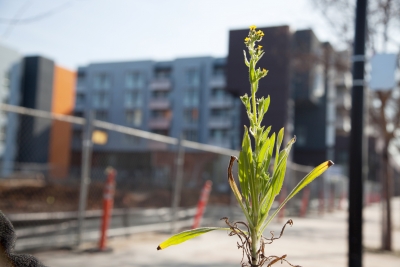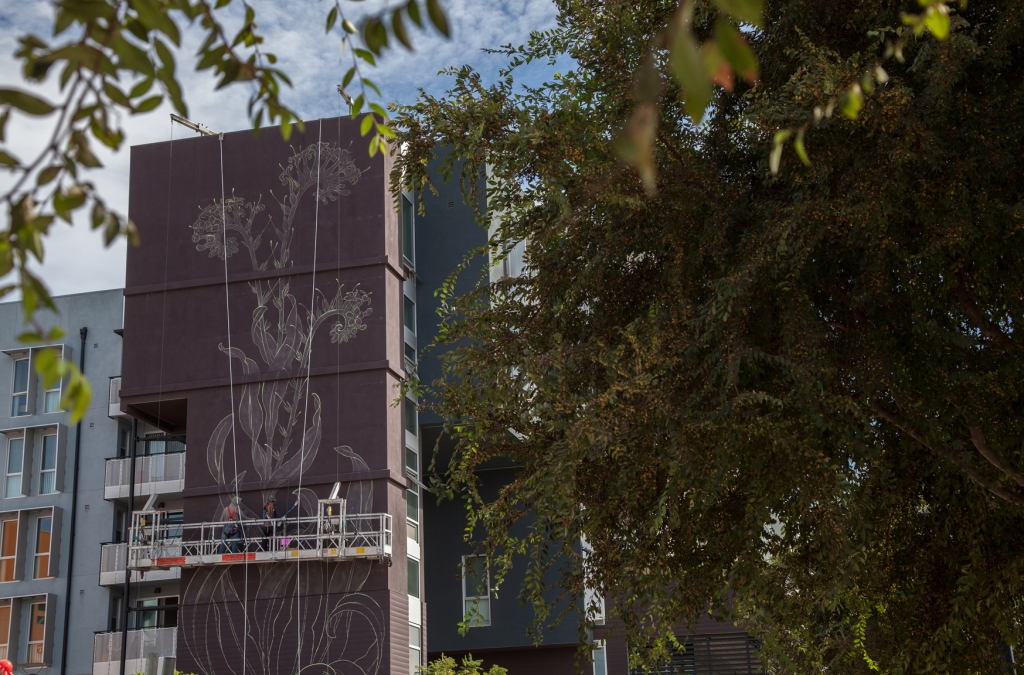Taking Root - in depth
This mural is painted on the first of many buildings that are slated for construction in this area, which is undergoing an impressively radical transformation. Once a polluted site, the land here was scraped and leveled, forming a tabula rasa for a brand new city. The first building to be built, developed by MidPen Housing and designed by SF’s David Baker + Partners Architects, stood in the midst of a lunar landscape at the time of construction.
When I first visited the future mural site in January 2012, there was no person nearby, no traffic. All the topsoil of this formerly toxic superfund site had been freshly removed once more, and with it the memory of any vegetation therein.
I scoured the ground for signs of live, and the closest visible thing to the mural site that I found was a small wildflower, amsinckia menziesii - a “common fiddleneck”.
This was to be what I would feature in my mural at the largest scale: the tiny vanguard-flower, the resilient little tuft of green that made it back first, with the rest of nature following at its heels.

This little plant represents the unplanned kind of land healing that needn't wait for funding and civic processes to move forward. It wouldn’t be long until that wildflower would be paved over again, covered with rubberized playground flooring, or replaced with obedient turf, as the land gets healed in a different way according to human needs and priorities. Nevertheless, I felt that this tiny rebel front runner of natural land reclamation, the bringer of a relief of chaos into planned order, was to be the hero of my mural, as it may be the first to disappear again. But not for long.
The roots - the people
In contrast to the giant scale of the wildflower, there is a second part to the mural, at the roots of the plant, which contains small-scale details that the community helped envision.
I called a meeting with the newly arrived residents, most of whom are from sundry and distant origins, to find a way to express pictorially what heterogeneous roots our spontaneous plant will grow from.
It was a group of kids who suggested to write greetings or welcoming phrases in every language spoken at Station Center. In the words of Elias, the well-spoken 9 year old son of a Moroccan couple, "everyone here has roots in different parts of the world, and together we grow and blossom as a community."
It wasn't necessary for me to collect the writings ahead of time: people just came and contributed them on the fly. Some wrote them on a piece of paper for me to copy, others painted theirs themselves. Mothers, teenagers, men at work, and seniors contributed a welcoming phrase in their language. It was fun when they each later returned with a gaggle of their peers to show it off.
One lady asked her brother in Taiwan, a calligraphy artist, to stylize a "welcome" in mandarin especially for this mural. I'm relieved to say I apparently did an ok job copying it.
Mubarra Ahmadyar from Afghanistan was among the building's residents. An art student, talented calligrapher, and mother of four, she became a precious helper with the lettering. I'm grateful for her help and pleasant company.
In addition to the “international roots”, there are two shapes that also feed into the roots of the giant wildflower. One shows what came before, and the other imagines what could be.
The Past



